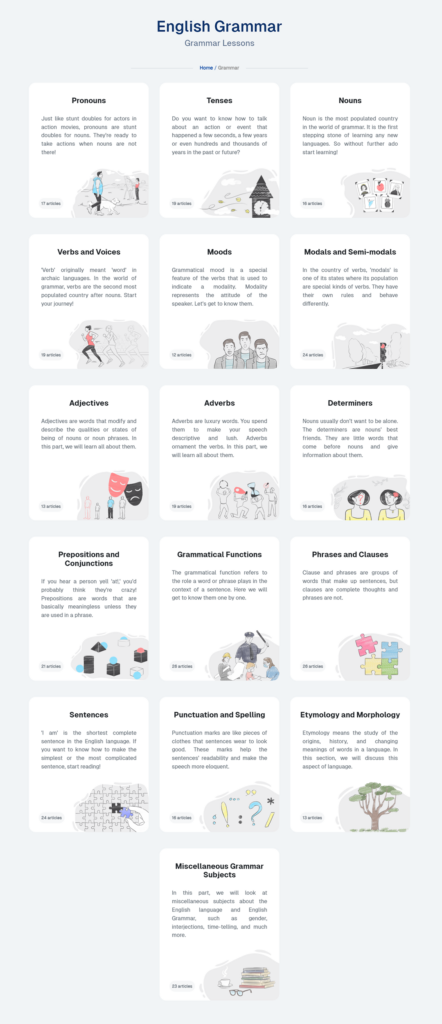The LanGeek Grammar Page serves as a comprehensive guide for understanding the intricate rules and structures of the English language. From pronouns to tenses, nouns to adverbs, this resource covers essential grammar concepts. Whether you’re a beginner seeking foundational knowledge or an advanced learner aiming for precision, LanGeek provides clear explanations and practical examples to enhance your language skills. It consists of 16 different grammatical categories:
 Pronouns:
Pronouns:
- These replace nouns to avoid repetition. Personal pronouns (like “he,” “she,” and “they”) show grammatical person and gender.
- Tenses:
- Indicate when an action happens. From present simple to future perfect, tenses allow us to talk about events in different time frames.
- Nouns:
- Name people, places, things, and ideas. Common or proper, singular or plural, nouns are the building blocks of language.
- Verbs and Voices:
- Verbs express actions or states. Active voice emphasizes the doer, while passive voice shifts focus to the receiver.
- Moods:
- Indicate the speaker’s attitude. From indicative to subjunctive, moods affect how we express certainty, possibility, or necessity.
- Modals and Semi-Modals:
- Modals express necessity, ability, or permission. Semi-modals (like “have to” and “used to”) add nuances.
- Adjectives:
- Describe qualities or states of nouns. From “beautiful” to “enormous,” adjectives enhance our descriptions.
- Adverbs:
- Modify verbs, adjectives, or other adverbs. Whether modifying time, place, or manner, adverbs add depth to sentences.
- Determiners:
- Come before nouns to give information. Articles (“a,” “an,” “the”) and possessives fall into this category.
- Prepositions and Conjunctions:
- Prepositions show relationships (like “in,” “on,” or “under”). Conjunctions link ideas (like “and,” “but,” or “because”).
- Grammatical Functions:
- Roles words or phrases play in sentences. Whether subject, object, or complement, understanding functions constructs meaningful sentences.
- Phrases and Clauses:
- Groups of words that make up sentences. Clauses convey complete thoughts, while phrases do not.
- Sentences:
- Express complete ideas. From simple to complex, understanding sentence structures allows effective communication.
- Punctuation and Spelling:
- Punctuation marks enhance readability. Proper spelling ensures clarity and precision.
- Etymology and Morphology:
- Etymology explores word origins and changing meanings. Morphology studies word forms and structure.
- Miscellaneous Grammar Subjects:
- Cover various aspects, including gender, interjections, and more.